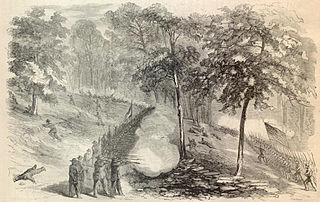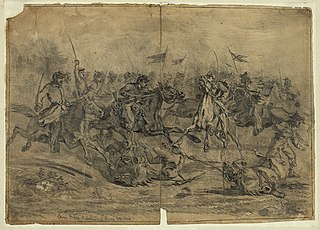
The Second Battle of Bull Run or Battle of Second Manassas was fought August 28–30, 1862, in Prince William County, Virginia, as part of the American Civil War. It was the culmination of the Northern Virginia Campaign waged by Confederate Gen. Robert E. Lee's Army of Northern Virginia against Union Maj. Gen. John Pope's Army of Virginia, and a battle of much larger scale and numbers than the First Battle of Bull Run fought on July 21, 1861 on the same ground.

The Battle of Chickamauga, fought on September 19–20, 1863, between Union and Confederate forces in the American Civil War, marked the end of a Union offensive, the Chickamauga Campaign, in southeastern Tennessee and northwestern Georgia. It was the first major battle of the war fought in Georgia, the most significant Union defeat in the Western Theater, and involved the second-highest number of casualties after the Battle of Gettysburg.

The First Battle of Bull Run, also known as the Battle of First Manassas, was the first major battle of the American Civil War. The battle was fought on July 21, 1861, in Prince William County, Virginia, just north of the city of Manassas and about thirty miles west-southwest of Washington, D.C. The Union's forces were slow in positioning themselves, allowing Confederate reinforcements time to arrive by rail. Each side had about 18,000 poorly trained and poorly led troops. It was a Confederate victory, followed by a disorganized retreat of the Union forces.

The Battle of Chantilly took place on September 1, 1862, in Fairfax County, Virginia, as the concluding battle of the Northern Virginia Campaign of the American Civil War. Thomas J. "Stonewall" Jackson's corps of the Army of Northern Virginia attempted to cut off the line of retreat of the Union Army of Virginia following the Second Battle of Bull Run but was attacked by two Union divisions. During the ensuing battle, Union division commanders Isaac Stevens and Philip Kearny were both killed, but the Union attack halted Jackson's advance.

The Battle of South Mountain—known in several early Southern accounts as the Battle of Boonsboro Gap—was fought on September 14, 1862, as part of the Maryland campaign of the American Civil War. Three pitched battles were fought for possession of three South Mountain passes: Crampton's, Turner's, and Fox's Gaps. Maj. Gen. George B. McClellan, commanding the Union Army of the Potomac, needed to pass through these gaps in his pursuit of Confederate General Robert E. Lee's precariously divided Army of Northern Virginia. Although the delay bought at South Mountain would allow him to reunite his army and forestall defeat in detail, Lee considered termination of the Maryland Campaign at nightfall.

The Battle of Brandy Station, also called the Battle of Fleetwood Hill, was the largest predominantly cavalry engagement of the American Civil War, as well as the largest ever to take place on American soil. It was fought on June 9, 1863, around Brandy Station, Virginia, at the beginning of the Gettysburg Campaign by the Union cavalry under Maj. Gen. Alfred Pleasonton against Maj. Gen. J.E.B. Stuart's Confederate cavalry.

The Battle of Williamsburg, also known as the Battle of Fort Magruder, took place on May 5, 1862, in York County, James City County, and Williamsburg, Virginia, as part of the Peninsula Campaign of the American Civil War. It was the first pitched battle of the Peninsula Campaign, in which nearly 41,000 Federals and 32,000 Confederates were engaged, fighting an inconclusive battle that ended with the Confederates continuing their withdrawal.
The Battle of Beaver Dam Creek, also known as the Battle of Mechanicsville or Ellerson's Mill, took place on June 26, 1862, in Hanover County, Virginia, was the first major engagement of the Seven Days Battles during the Peninsula Campaign of the American Civil War. It was the start of Confederate General Robert E. Lee's counter-offensive against the Union Army of the Potomac, under Maj. Gen. George B. McClellan, which threatened the Confederate capital of Richmond. Lee attempted to turn the Union right flank, north of the Chickahominy River, with troops under Maj. Gen. Thomas J. "Stonewall" Jackson, but Jackson failed to arrive on time. Instead, Maj. Gen. A.P. Hill threw his division, reinforced by one of Maj. Gen. D.H. Hill's brigades, into a series of futile assaults against Brig. Gen. Fitz John Porter's V Corps, which occupied defensive works behind Beaver Dam Creek. Confederate attacks were driven back with heavy casualties. Porter withdrew his corps safely to Gaines Mill, with the exception of Company F of the 8th Pennsylvania Reserve Regiment who did not receive the orders to retreat.

The Battle of Gaines' Mill, sometimes known as the Battle of Chickahominy River, took place on June 27, 1862, in Hanover County, Virginia, as the third of the Seven Days Battles of the American Civil War. Following the inconclusive Battle of Beaver Dam Creek (Mechanicsville) the previous day, Confederate General Robert E. Lee renewed his attacks against the right flank of the Union Army, relatively isolated on the northern side of the Chickahominy River. There, Brig. Gen. Fitz John Porter's V Corps had established a strong defensive line behind Boatswain's Swamp. Lee's force was destined to launch the largest Confederate attack of the war, about 57,000 men in six divisions. Porter's reinforced V Corps held fast for the afternoon as the Confederates attacked in a disjointed manner, first with the division of Maj. Gen. A.P. Hill, then Maj. Gen. Richard S. Ewell, suffering heavy casualties. The arrival of Maj. Gen. Stonewall Jackson's command was delayed, preventing the full concentration of Confederate force before Porter received some reinforcements from the VI Corps.

The Battle of Cedar Mountain, also known as Slaughter's Mountain or Cedar Run, took place on August 9, 1862, in Culpeper County, Virginia, as part of the American Civil War. Union forces under Maj. Gen. Nathaniel P. Banks attacked Confederate forces under Maj. Gen. Thomas J. "Stonewall" Jackson near Cedar Mountain as the Confederates marched on Culpeper Court House to forestall a Union advance into central Virginia. After nearly being driven from the field in the early part of the battle, a Confederate counterattack broke the Union lines resulting in a Confederate victory. The battle was the first combat of the Northern Virginia campaign.

The First Battle of Rappahannock Station, as took place on August 23, 1862, at present-day Remington, Virginia, as part of the Northern Virginia Campaign of the American Civil War.

The Manassas Station Operations included the operations known as Bristoe Station, Kettle Run, Bull Run Bridge, or Union Mills. It took place August 25–27, 1862, in Prince William County, Virginia, as part of the Northern Virginia Campaign of the American Civil War.

The Battle of Aldie took place on June 17, 1863, in Loudoun County, Virginia, as part of the Gettysburg Campaign of the American Civil War.

The Bristoe campaign was a series of minor battles fought in Virginia during October and November 1863, in the American Civil War. Maj. Gen. George G. Meade, commanding the Union Army of the Potomac, began to maneuver in an unsuccessful attempt to defeat Gen. Robert E. Lee's Army of Northern Virginia. Lee countered with a turning movement, which caused Meade to withdraw his army back toward Centreville. Lee struck at Bristoe Station on October 14, but suffered losses in two brigades and withdrew. As Meade followed south once again, the Union army smashed a Confederate defensive bridgehead at Rappahannock Station on November 7 and drove Lee back across the Rapidan River. Along with the infantry battles, the cavalry forces of the armies fought at Auburn on October 13, again at Auburn on October 14, and at Buckland Mills on October 19.

The northern Virginia campaign, also known as the second Bull Run campaign or second Manassas campaign, was a series of battles fought in Virginia during August and September 1862 in the Eastern Theater of the American Civil War. Confederate General Robert E. Lee followed up his successes of the Seven Days Battles in the Peninsula campaign by moving north toward Washington, D.C., and defeating Maj. Gen. John Pope and his Army of Virginia.

Evander McIver Law was an author, teacher, and a Confederate general in the American Civil War.
The First Battle of Auburn was fought on October 13, 1863, between Union infantry and Confederate cavalry forces at the start of the Bristoe Campaign during the American Civil War. A Union infantry column stumbled upon a Confederate cavalry reconnaissance party and a short, inconclusive fight ensued. The Confederate cavalry withdrew in the face of the superior Union force, but a much larger body of Confederate cavalry under Maj. Gen. J.E.B. Stuart, attempting to raid a Union wagon train became entrapped by the column, forcing them to abandon the raid and hide in a ravine overnight awaiting Confederate infantry to come to their aid.
The following Confederate States Army units and commanders fought in the Second Battle of Bull Run, called the Second Battle of Manassas by Confederate records, of the American Civil War. The Union order of battle is listed separately. Order of battle compiled from the army organization during the battle, the casualty returns and the reports.

The Knoxville campaign was a series of American Civil War battles and maneuvers in East Tennessee during the fall of 1863 designed to secure control of the city of Knoxville and with it the railroad that linked the Confederacy east and west, and position the First Corps under Longstreet for return to the Army of Northern Virginia. Union Army forces under Maj. Gen. Ambrose Burnside occupied Knoxville, Tennessee, and Confederate States Army forces under Lt. Gen. James Longstreet were detached from Gen. Braxton Bragg's Army of Tennessee at Chattanooga to prevent Burnside's reinforcement of the besieged Federal forces there. Ultimately, Longstreet's Siege of Knoxville ended when Union Maj. Gen. William Tecumseh Sherman led elements of the Army of the Tennessee and other troops to Burnside's relief after Union troops had broken the Confederate siege of Chattanooga. Although Longstreet was one of Gen. Robert E. Lee's best corps commanders in the East in the Army of Northern Virginia, he was unsuccessful in his attempt to penetrate the Knoxville defenses and take the city.

Nathaniel Collins McLean, was a lawyer, farmer, and Union general during the American Civil War. He was appointed colonel of the 75th Ohio Infantry Regiment in 1861 and led the regiment in several battles before commanding a brigade. During the Second Battle of Bull Run, his brigade's determined defense of Chinn Ridge probably saved the Union Army from a disaster. He led a brigade at the Battle of Chancellorsville in 1863, for a month in the Atlanta campaign in 1864, and in the Carolina campaign in 1865. After the war, he returned to his law practice in Cincinnati, moved to Minnesota, and moved again to New York where he died.



















